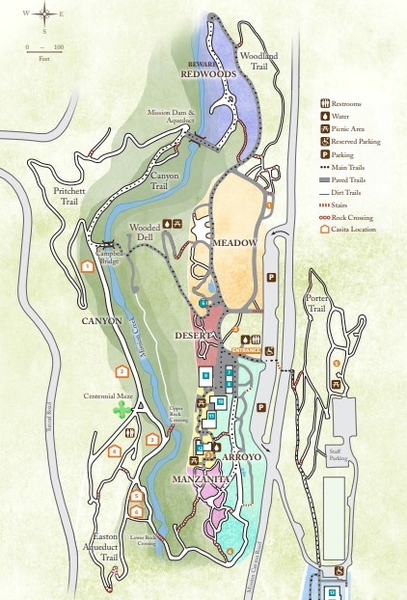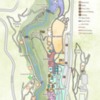Santa Barbara's Botanic Garden is one of those not-so-huge spaces that manage to look immense as you wander through it; you never quite realize how close you are to where you've been until you look at a map.
The carefully laid-out trails, 5.5 miles of them, wander through the 78 acres of the garden on different levels, facing different ways, shielded by dense plantings and other tricks of the landscape architect's trade.
Combined with the views to distant mountains and to other wooded areas that are outside the garden, the whole effect, unless you're looking for a particular garden, is to feel as if you're wandering around a particularly beautiful stretch of countryside.
Perhaps one of the reasons it feels so much like natural country is that while it has specimens of over a thousand different plants and trees, there are really no exotics: This is a California garden, focused on the flora of its region. Everything belongs here, whether it's a patch of plain-looking sagebrush and grass or the surprisingly pretty red-flowered buckwheat.
Everywhere, of course, there are golden poppies, the state flower. Sometimes alone, but popping up often in group portraits with colorful cousins.
There are paved paths in heavily-visited areas, but much of the trail system is graded dirt, especially in the woodlands area, adding to the feeling of being away and alone.
More of a rural feel here...
At various points, there's seating of various sorts, suitable for a rest on a warm spring day, as well as plenty of rocks to sit on and contemplate the views.
There's a juniper of a certain age in here...the sign says. It's described as the oldest 'recorded' plant in the garden, which is to say, the earliest planted after the Garden's official start in 1926, on land that once belonged to the Santa Barbara Mission.
The Garden is in Mission Canyon and the hills beside it, in the hills above the Mission itself. Almost hidden away in the backwoods of the garden are an 1807 dam that the Mission built to assure its water supply. It wasn't meant to create a reservoir; instead, it forced the stream's flow into a system of wooden aqueducts that carried it down to the mission.
The dam continued in use into the early 20th century, although the wooden ducts were replaced with steel pipes and a filter system was added.
This is California, so of course there are redwoods. But since there were none when the garden was started, they had to be planted. These are described as 'babies,' planted in 1926 and 1930. True, they're not 18 feet across and 350 feet tall, but they are impressively tall, and growing. Check back in a couple of hundred years!
If redwoods growing in moist forest lands are California, so are the cacti and other succulents that make their home in drier areas. There are quite a few in the garden, in several areas reflecting different levels of dry and not-so-dry.
The one just above has the odd name of 'live-forever.' Actually, that's one of its least-odd names: It's also called orpine, livelong, frog's-stomach, harping Johnny, life-everlasting, midsummer-men, Orphan John and witch's moneybags. You'd think it would be too embarrassed to live forever!
There were quite a few lizards of various sizes to be seen, mostly sunning themselves on the rocks, but occasionally darting across the path and for one brief moment one of them stopped on the toe of my shoe. I wasn't fast enough for a picture of that!
The palm trees below came to the garden in 1934 from the Coachella Valley, and burned in the 2009 Jesusita Fire that damaged large parts of the garden. They are adapted to survive fires and have very thick trunks; the charred trunks protect against future fires. You can see new growth starting at the top.
Meet opuntia erinacea erinacea, another character with a string of names. Given how much it resembles a shaggy animal, you won't be surprised to know it's sometimes called a hedgehog prickly pear. Or a Mojave prickly pear. But it's not so clear why some call it a grizzly bear prickly pear.
Agave, brittlebush, and around a final corner, the gift shop and refreshments!
The Garden's original 1926 plan, always dedicating it to propagation, display and study of California plants, continued developing over the next twenty-five years. And, it's not done: next June, a new section will open. Called The Backcountry, it's meant to be a 'wild space' where young people can "climb, jump, run, gaze, and wonder at their rich and natural surroundings." Sounds like fun, even for the not-young among us!


Comments (0)